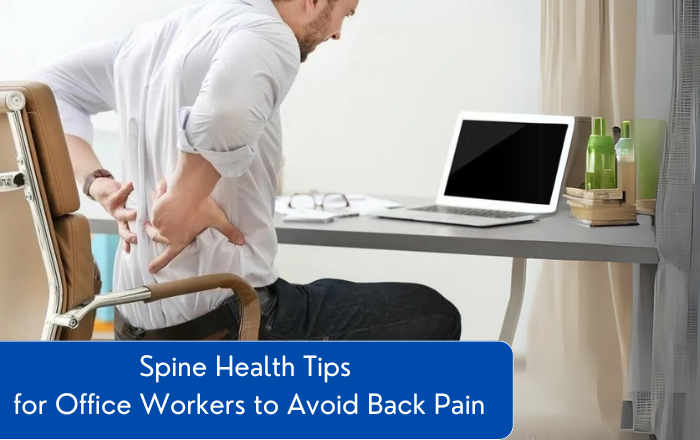If you work at a desk for long hours, you might have felt that annoying stiffness in your back or the occasional sharp pain in your lower spine. Sitting for long periods with poor posture can take a serious toll on your spine, leading to discomfort that affects your work and daily life.
The good news is that small adjustments can make a big difference. By improving your posture, making changes to your workspace, and incorporating simple exercises, you can keep your spine healthy and avoid long-term problems. In this blog, we’ll explore how to maintain spine health while working long hours at a desk and when to seek medical attention if needed.
How Poor Posture Affects Your Spine
Many office workers develop back pain without realizing the root cause—poor posture. Sitting hunched over a desk for hours puts pressure on the lower back, shoulders, and neck. Over time, this strain leads to:
✅ Chronic back pain – A dull or sharp pain that worsens with prolonged sitting.
✅ Neck and shoulder tension – Tightness due to slouching or improper monitor placement.
✅ Weakened spinal muscles – Lack of movement weakens the muscles that support the spine.
✅ Poor circulation – Sitting too long can slow down blood flow, causing stiffness and discomfort.
By understanding these issues, you can take steps to protect your spine and reduce discomfort.
Setting Up an Ergonomic Workspace
Creating a spine-friendly workspace is key to preventing back pain. Here’s how to set up your desk and chair for better support:
1. Choose a Supportive Chair
- Use a chair with lumbar support to maintain the natural curve of your lower back.
- Adjust the seat height so your feet rest flat on the floor.
- Your knees should be at a 90-degree angle to reduce strain.
2. Position Your Computer Screen Properly
- The top of your monitor should be at eye level to prevent neck strain.
- Keep the screen at arm’s length (about 20–30 inches away).
- If using a laptop, consider a separate keyboard and mouse to keep a comfortable posture.
3. Keep Your Keyboard & Mouse Close
- Your elbows should be at a 90-degree angle while typing.
- Avoid stretching too far forward to reach your keyboard.
4. Rest Your Feet on the Floor
- If your feet don’t reach the floor, use a footrest for support.
- Avoid crossing your legs, as it can disrupt blood circulation.
Simple Exercises & Stretches for a Pain-Free Spine
Staying in one position for too long can cause stiffness. Try these easy office exercises to prevent lower back pain:
1. Seated Spinal Twist
Sit upright in your chair.
Place your right hand on your left knee and twist your torso gently to the left.
Hold for 10 seconds, then switch sides.
2. Shoulder Rolls
Lift your shoulders toward your ears and roll them back in a circular motion.
Repeat 10 times to relieve tension.
3. Neck Stretches
Gently tilt your head to one side, bringing your ear toward your shoulder.
Hold for 10 seconds and repeat on the other side.
4. Standing Back Stretch
Stand up and place your hands on your lower back.
Lean slightly backward to stretch the spine.
Hold for 10 seconds.
How Often Should You Take Breaks at Work to Prevent Back Pain?
Sitting for long hours puts constant pressure on your spine, so taking short breaks can help. Here are some simple strategies:
- Follow the 30-30 rule – Every 30 minutes, stand up and move for at least 30 seconds.
- Use a standing desk – If possible, alternate between sitting and standing.
- Walk during calls – Take phone calls while walking around your workspace.
When Should You See a Doctor for Back Pain?
If your back pain doesn’t go away despite making changes, it might be time to see a doctor. Watch out for these warning signs:
- Pain that lasts more than two weeks
- Numbness or tingling in your legs
- Difficulty standing or walking
- Pain that worsens at night
If you experience any of these symptoms, seeking medical advice can help prevent serious complications.
Meet Dr. Shrikant Dalal – Orthopedic Doctor in Baner at Orthos Centre
If you’re struggling with chronic back pain or spine-related issues, consulting an orthopedic specialist can help. Dr. Shrikant Dalal specializes in diagnosing and treating back pain, helping office workers find long-term relief.
At Orthos Centre in Baner, he offers guidance on posture correction, exercises, and treatment options for back pain. Don’t let discomfort affect your daily life—schedule an appointment today!
Visit Orthos Centre in Baner
FAQs
1. What is the best sitting position for spine health?
The best position is sitting upright with feet flat on the floor, knees at a 90-degree angle, and lower back supported.
2. How can I stop back pain from sitting too long?
Take breaks every 30 minutes, stretch regularly, and maintain an ergonomic workspace.
3. What exercises help with lower back pain?
Seated spinal twists, back stretches, and core-strengthening exercises can provide relief.


